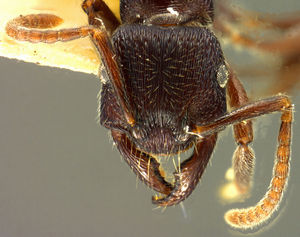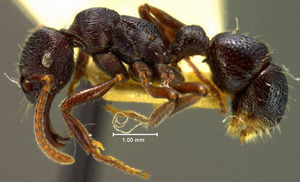Poneracantha semiferox
| Poneracantha semiferox | |
|---|---|

| |
| Scientific classification | |
| Kingdom: | Animalia |
| Phylum: | Arthropoda |
| Class: | Insecta |
| Order: | Hymenoptera |
| Family: | Formicidae |
| Subfamily: | Ectatomminae |
| Tribe: | Ectatommini |
| Genus: | Poneracantha |
| Species: | P. semiferox |
| Binomial name | |
| Poneracantha semiferox (Brown, 1958) | |
Known from the collection of 3 type workers from moist forest between 900-1200 m in the Dominican Republic.
Identification
A member of the semiferox complex (in the banksi subgroup of the rastrata species group). In the development of the mandibles, semiferox is intermediate between Gnamptogenys schmitti and Poneracantha banksi on the one hand and Poneracantha mediatrix on the other. In sculpture, semiferox is closest to schmitti, but shows tendencies toward the irregular, coarse, partly reticulate or punctate sculpture even better developed in banksi. The mandibles of semiferox are differ from schmitti, including in cross section: shining and longitudinally rugulose, as opposed to opaque and striate in schmitti. In the lack of a dorsal tooth on the posterior coxa, and in the smooth postpetiolar sternum, schmitti and semiferox are alike and distinctive, but other Gnamptogenys lack the coxal armament, and banksi has a partly smooth postpetiolar sternum (from Brown 1958 and Lattke 1995).
Keys including this Species
Distribution
Latitudinal Distribution Pattern
Latitudinal Range: 18.72° to 18.72°.
| North Temperate |
North Subtropical |
Tropical | South Subtropical |
South Temperate |
- Source: AntMaps
Distribution based on Regional Taxon Lists
Neotropical Region: Dominican Republic (type locality), Greater Antilles.
Distribution based on AntMaps
Distribution based on AntWeb specimens
Check data from AntWeb
Countries Occupied
| Number of countries occupied by this species based on AntWiki Regional Taxon Lists. In general, fewer countries occupied indicates a narrower range, while more countries indicates a more widespread species. |

|
Estimated Abundance
| Relative abundance based on number of AntMaps records per species (this species within the purple bar). Fewer records (to the left) indicates a less abundant/encountered species while more records (to the right) indicates more abundant/encountered species. |

|
Biology
Castes
Worker
  
| |
| . | |
Nomenclature
The following information is derived from Barry Bolton's Online Catalogue of the Ants of the World.
- semiferox. Gnamptogenys semiferox Brown, 1958g: 324, fig. 14 (w.) DOMINICAN REPUBLIC.
- Type-material: holotype worker, 2 paratype workers.
- Type-locality: holotype Dominican Republic: Mt Diego de Ocampo, 3000-4000 ft, vii.1938 (P.J. Darlington); paratypes with same data.
- Type-depositories: MCZC (holotype); MCZC, MZSP (paratypes).
- Combination in Poneracantha: Camacho, Franco, Branstetter, et al. 2022: 11.
- Status as species: Kempf, 1972a: 114; Bolton, 1995b: 210; Lattke, 1995: 182; Lattke, et al. 2007: 261 (in key); Lubertazzi, 2019: 118; Camacho, et al. 2020: 459 (in key); Camacho, Franco, Branstetter, et al. 2022: 11.
- Distribution: Dominican Republic.
Unless otherwise noted the text for the remainder of this section is reported from the publication that includes the original description.
Lattke (1995): Diagnosis - Body with abundant coarse punctation, especially on head; mandibles with about six denticles and projecting basal lobe; anterior clypeal margin convex; declivitous propodeal face longitudinally costulate.
Description
Worker
Holotype worker: TL 7.0, HL 1.43, HW (across eyes) 1.44, HW (at anterior corners) 1.39, closed mandibles extend about 0.81 mm., WL 1.99, petiole L 0.74, greatest eye diameter 0.29, scape L 1.11, absolute exposed length of left mandible 1.32; CI 97. Differs from Gnamptogenys (=Emeryella) schmitti workers of about the same size in its narrower head; shorter, broader, differently formed mandibles; and in the longer petiolar node, which is a trifle longer than broad seen from above. The median clypeal lobe is more prominent, and its anterior border is entire and evenly convex in outline. The sculpture differs in a number of ways.
The costulation throughout, but particularly on the head and pronotum, is finer, less uniform and even, less shining, and a little less distinct. The interspersed punctation, very sparse and insignificant in schmitti, is more abundant, coarser and considerably more distinct in semiferox, especially on the head, but it still does not interfere seriously with the regularity of the costulation except in the areas just mesad of the compound eyes and on the dorsolateral surfaces of the propodeum. The punctures are mostly indistinctly bounded, but contain piligerous tubercles. The dorsal face of the propodeum is longitudinally and subvermiculately costulate (evenly and transversely in schmitti). Color deep piceous, as in fully pigmented schmitti, appearing black to the naked eye. The appendages are more reddish.
Type Material
The holotype (Museum of Comparative Zoology) and two very similar paratypes (Coll. Borgmeier, MCZC) all bear the same data: Mt. Diego de Ocampo, 3000-4000 feet altitude, Dominican Republic, July, 1938 (P. J. Darlington leg.). Dr. Darlington tells me that the type locality was chiefly rain forest in which small palms were prominent, but that the land was being cleared for agriculture even at the time of his visit.
References
- Brown, W. L., Jr. 1958g. Contributions toward a reclassification of the Formicidae. II. Tribe Ectatommini (Hymenoptera). Bulletin of the Museum of Comparative Zoology 118: 173-362. (page 324, figs. 14 worker described)
- Camacho, G.P., Franco, W., Branstetter, M.G., Pie, M.R., Longino, J.T., Schultz, T.R., Feitosa, R.M. 2022. UCE phylogenomics resolves major relationships among Ectaheteromorph ants (Hymenoptera: Formicidae: Ectatomminae, Heteroponerinae): A new classification for the subfamilies and the description of a new genus. Insect Systematics and Diversity 6(1): 5; 1–20 (doi:10.1093/isd/ixab026).
- Lattke, J. E. 1995. Revision of the ant genus Gnamptogenys in the New World (Hymenoptera: Formicidae). J. Hym. Res. 4: 137-193.
- Lattke, J.E., Fernández, F. & Palacio, E.E. 2007. Identification of the species of Gnamptogenys Roger in the Americas (pp. 254-270). In Snelling, R.R., Fisher, B.L. & Ward, P.S. (eds). Advances in ant systematics: homage to E.O. Wilson – 50 years of contributions. Memoirs of the American Entomological Institute 80: 690 pp.
References based on Global Ant Biodiversity Informatics
- Brown W. L., Jr. 1958. Contributions toward a reclassification of the Formicidae. II. Tribe Ectatommini (Hymenoptera). Bulletin of the Museum of Comparative Zoology 118: 173-362.
- Kempf, W.W. 1972. Catalago abreviado das formigas da regiao Neotropical (Hym. Formicidae) Studia Entomologica 15(1-4).
- Lattke J. E. 1995. Revision of the ant genus Gnamptogenys in the New World (Hymenoptera: Formicidae). Journal of Hymenoptera Research 4: 137-193
- Perez-Gelabert D. E. 2008. Arthropods of Hispaniola (Dominican Republic and Haiti): A checklist and bibliography. Zootaxa 1831:1-530.


